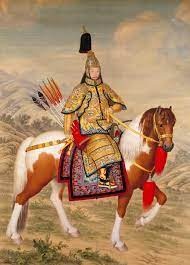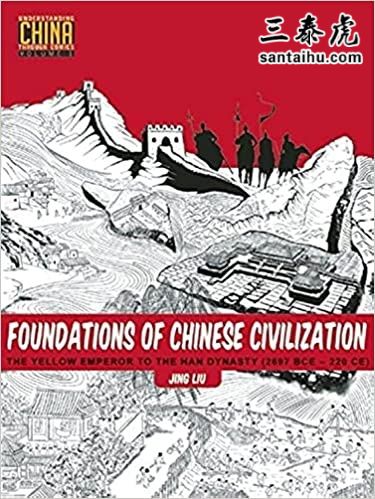How did ancient Chinese Emperors govern China given the poor communication technology and China's huge land mass and population?
古时候通讯技术落后,中国幅员辽阔,人口众多,中国皇帝是如何治理中国的?
以下是Quora网友的评价:
World Geopolitics.
The ancient Chinese Emperors governed China through a combination of centralized bureaucratic systems, regional autonomy, and the use of a sophisticated road network and messenger system.
中国古代皇帝通过中央的官僚制度、区域自治以及复杂的道路网络和馆驿系统来统治中国。

The centralized bureaucratic system was established during the Han Dynasty (206 BC – 220 AD) and was further developed and refined over time. The system consisted of a series of government offices, each with specific responsibilities and hierarchies. The Emperor was at the top of this bureaucracy and was assisted by a large number of officials, who were responsible for everything from taxation and public works to military and foreign affairs.
Regional autonomy was also a key aspect of ancient Chinese governance. The country was divided into provinces, each of which was ruled by a governor who had a degree of autonomy in managing the affairs of his province. This system helped to maintain stability and allowed for the effective management of the vast territory.
中央的官僚制度在汉朝(公元前206年-公元220年)开始建立,并随着时间的推移而进一步发展和完善。该系统由一系列政府机构组成,每个机构都有特定的职责和等级。皇帝是这个官僚机构的最高领导人,由一大批官员辅佐,官员们负责从税收、公共工程到军事、外交事务等一切事务。
区域自治也是中国古代治理的一个重要方面。中国被划分为若干省份,每个省份都由一名总督统治,总督在管理本省的事务方面有一定程度的自主权。这一制度有助于维持稳定,可以对广大领土进行有效的管理。
Finally, the ancient Chinese also had a sophisticated road network and messenger system, which helped to ensure that communication was as efficient as possible. The road network was designed to facilitate the movement of troops and goods across the country, and messengers were stationed at key points along the roads to ensure that information could be quickly and accurately transmitted.
If you want to know more about chinese Emperors and their governance way then read this book.
最后,古代中国还有复杂的道路网络和馆驿系统,这有助于确保高效的沟通。道路网络的设计是为了方便军队和货物在全国范围内的移动,馆驿驻扎在道路沿线的重要地点,能确保信息得到快速准确地传递。
如果你想了解更多关于中国皇帝和他们的统治方式,那就读一读这本书吧。

Understanding China
On the basis of ancient China’s social structure, a centralized monarchical political system was formed.
In ancient China, one of the most prominent features of the political system was the centralization of power. Localities were subject to the central government, while the central government was at the discretion of the emperor. The emperor was the core of the centralized political system in ancient China and was the supreme political head of the country with the highest power and status, based on which a systematic and perfect imperial system was built.
在中国古代社会结构的基础上,形成了中央的君主政治制度。
在古代中国,政治制度的一个最突出的特征是权力的集中。地方政府服从中央政府,而中央政府则听命于皇帝。皇帝是中国古代中央政治制度的核心,是国家的最高政治领袖,拥有至高无上的权力和地位,建立了系统完善的帝王制度。
To realize their will, they needed to firmly grasp and control the state apparatus and establish an orderly and hierarchical succession system, of which the official system was an important part.
The ancient Chinese official system formed a pyramidal structure in which imperial power was supreme. In the state governance, the emperor was the highest decision-maker, and all officials were subject to his will. To prevent the reduction of the emperorism, the emperor would appoint different officials to keep the balance.
为了实现他们的意愿,皇帝需要牢牢掌握和控制国家机器,建立有序的等级继承制度,而官员制度是其中的重要组成部分。
中国古代的官僚制是一个金字塔式的结构,皇权至高无上。在国家治理中,皇帝是最高决策者,所有官员都服从他的意志。为了防止皇权的削弱,皇帝会任命不同的官员来进行制衡。
Starting from Qin Shi Huang, the emperor held the country’s supreme power and dominated the provincial bureaucracy through the prime minister, firmly controlling the central departments, the local prefectures, and counties.
On behalf of the emperor, the local officials exercised administrative power over the provinces, the counties, and the local gentry, thus forming a monarchic country where “one family dominates the whole nation.”
从秦始皇开始,皇帝掌握着国家的最高权力,并通过宰相控制了各省的官僚机构,牢牢控制着中央各部、地方郡县。
地方官员代表着皇帝,对各省、县和地方士绅行使行政权力,从而形成了一个“一家统治全国”的君主国家。
Specifically, the central system in ancient China consisted of the Prime Ministerial System (Zai iang Zhi Du) and the System of Three Departments and Six Ministries (San Sheng Liu Bu).
The prime minister was a decisive administrative official second only to the emperor, leading the departments and ministries to manage the country for the emperor.
The central institutions of ancient China were embodied in the system of Three Departments and Six Ministries. As an important political system for governing the country in ancient China and a relatively complete and systematic central political system, it originated in the Han Dynasty (202 BCE - 220 CE), got established in the Sui Dynasty (518 - 618), matured in the Tang Dynasty (618 - 907), and remained until the late Qing Dynasty (1636 - 1912).
具体来说,中国古代的中央制度包括宰相制和三省六部制。
宰相是地位仅次于皇帝的具有决断权的行政官员,领导各部为皇帝管理国家。
中国古代的中央机构主要体现在三省六部制度上,这是中国古代重要的政治制度,是比较完整和系统的中央政治制度。三省六部制发源于汉代(公元前202年—公元220年),建制于隋朝(公元518年—618年),成熟于唐朝(公元618年—907年),并一直延续到清末(1636年—1912年)。
Freddie Chen
Basically, you can combine the answers of Robin Daverman and Luca Yang . I agree most part of their answers.
The ancient European countries adopted feudal system by which King granted vassal power to rule the territories.
It happened in Dynasty Zhou. And we can see the problem, vassals may fight each other and even fight against the King later. Qin Shi Huang, the founder of Qin Dynasty and the 1st emperor in China history, is just the vassal lord of Zhou Dynasty.
你可以把Robin Daverman和Luca Yang的答案结合起来阅读。我同意他们大部分的回答。
古代欧洲国家采用封建制,国王授予属国统治领土的权力。
中国在周朝就是这样的。我们从中发现了一个问题:诸侯之间可能会争战不休,甚至还会背叛国王。秦始皇,秦朝的缔造者,中国历史上第一个皇帝,就曾是周朝的诸侯。
From Dynasty Qin, China became a centralism country. Emperor divided the country into provinces, counties, cities and appoint bureaucrats to rule the place directly. It is the bureaucracy system. And later with the perfection of the civil service examination system. Such system helps the empire control large territory.
Though, we all call ancient China a centralism country. We do not think it is ruled by only the emperors. It is a country ruled together by the Emperors and gentry-scholar class.
Emperors is the represent of the power. They always call themselves “son of the Sky” which is kind like “divine right” shows the legitimacy of its power to rule China.
从秦朝开始,中国成为一个中央国家。皇帝将国家划分为省、县、市,并任命官员直接统治地方。这是官僚体制。后来随着公务员考试制度的完善,这样的制度有助于帝国控制广阔的疆土。
不过,我们称古代中国为中央国家。我们不认为国家只由皇帝一人统治,而是由皇帝和士绅阶层共同统治。
皇帝是权力的代表。他们总是自称“天子”,有点像“神授权力”,显示了他们统治国家的合法性。
Scholar, usually refer to Confucian scholar, made up of the outstanding people comes from the civil service examination system, forms the bureaucracy system. The civil service examination system give normal people, even peasants offspring, the chance to become upper class. And they break the gentry class’s monopoly of the power and provide fresh blood to ruling class.
Gentry class, once was the only ruling class before Sui-Tang Dynasty. Later they become the land lords take the control of towns and villages level administrative region. Sometime you can look them as local King who can made some local laws with their power.
士大夫,通常指儒生,由通过科举制度中胜出的优秀人才组成,形成了科层制。科举制度给普通人,甚至农民的后代,跻身上流社会的机会。他们打破了士绅阶级对权力的垄断,为统治阶级提供了新鲜血液。
士绅阶级,在隋唐以前曾是唯一的统治阶级。后来他们成为地主,控制乡镇一级的行政区域。你也可以把他们看作是地方的王,他们可以用自己的权力制定一些地方法律。
Jean-Luc Liu
It is done through a system of roads and government-owned stables and inns. When the Emperor gave an order, the messenger rode his horse to death to get to the next stable in the network, where he exchanged his horse and move on to the next stable. This process is repeated until he reaches his destination.
As a side note, even for the most stable and prosperous dynasties, rebellion in the border region is extremely common. Therefore, while this system works fine for the rich provinces close to the capital, it does not work so well for the relatively poorer border provinces.
它是通过道路系统和政府驿站来实现的。皇帝下了诏令,馆驿就骑马送至下一个驿站,换马并继续前往下一个驿站。这个过程不断重复,直到送达目的地。
顺便说一句,即使是在最稳定、最繁荣的朝代,边境地区的叛乱也极为普遍。因此,虽然这一制度对临近首都的富裕省份很有效,但对相对贫穷的边境省份却不太奏效。
Layla Ouyang
Not all Chinese Emperor were “always living inside his palace and cut out from the people.” We also had our “Hadrian” who enjoyed touring around China.
This is Emperor Qianlong (reign from 1736-1795) of Qing dynasty. During his reign he made 6 tours to Southern China and kept journals of the purposes and effects of these tours. By that time, the transportation was already very convenient: the network of postal offices and canals were highly developed.
并非所有的中国皇帝都“只住在自己的宫殿里,远离人民”。我们中国也出过一个喜欢出行的“哈德良皇帝”。
我说的就是清朝的乾隆皇帝(在位时间1736-1795年)。他在位期间,六次前往中国南方,并记录了这些行程的目的和影响。那时,交通已经非常便利:驿站和运河网络高度发达。
But in Qing dynasty, absolute monarchy was already in its heyday.
Actually for a long time, there was no absolutely but increasingly effective administrative system for centralized governance of local areas in ancient imperial China. A relatively mature and functioning system of centralized imperial power went through a long formation process:
但在清朝,君主专制已经处于全盛时期。
实际上,在很长一段时间里,中国古代帝制时期并没有绝对的、但却日益有效的地方集中治理行政体系。一个相对成熟和高效的中央皇权系统经历了一个漫长的形成过程:
Enfeoffment, an aristocratic hereditary political system typically implemented in West Zhou (from approxmately 1046 to 771 BC).
To consolidate the newly established regime, the King divided the conquered land into hereditary fiefs to relatives and descendants of the ruling aristocratic family, and in return they pledged to protect the realm in times of war.
The King had very little control over these fiefs, which gradually became powerful realms of local kings.
分封制,西周(约公元前1046年至公元前771年)典型的贵族世袭政治制度。
为了巩固新建立的政权,国王将征服的土地划分为世袭封地,分给贵族家庭的亲戚和后代,作为回报,他们承诺在战争时期保护王国。
国王对这些封地几乎没有控制权,这些封地逐渐成为地方诸侯的强大领地。
Junxan zhi (郡县制), a bureaucratic system of centrally appointed local magistrates in “commanderies and counties.”
It was originated during the later Zhou's Spring and Autumn period (from approxmately 771 to 476 BC), when the Zhou’s vassal states, such as Qin, in, Wei, are rising and expanding territories. Their newly seized lands were not part of their original fiefs and were organized into counties (xàn).
郡县制,由中央在郡、县等地任命地方官员的官僚系统。
它起源于周朝后期的春秋时期(约公元前771年至公元前476年),当时周朝的诸侯国,如秦、晋、魏,都在崛起、扩张领土。他们新夺取的土地不再是原来的封地,而是新的县。
As more and more counties emerged, commanderies became the higher level administrative division above counties. Since then this local governing system, namely Junxan zhi, was widely established. Governors of commanderies and counties were directly appointed by the Emperor, which greatly strengthened central control of local regions.
随着县的增多,郡成了比县更高一级的行政区域。从那时起,这种地方治理制度,即郡县制,被广泛建立起来了。郡县长官由皇帝直接任命,这大大加强了中央对地方的控制。
The implementation of Junxan zhi abolishes the hereditary traditions of feudal aristocratic ruling and enables vertical management of the central government to the local government. It is an important symbol of bureaucracy replacing aristocracy.
Junxan zhi laid the foundation of subsequent local administrative systems in the following 2000 years of Chinese history. In Yuan dynasty, a larger division - the “province”- was established and still used in modern China. (See History of the administrative divisions of China before 1912 - Wikipedia)
郡县制的实行,废除了封建贵族统治的世袭传统,实现了中央政府对地方政府的纵向管理。它是官僚制取代贵族制的重要标志。
郡县制为中国2000多年的地方行政制度奠定了基础,元朝出现了更大的行政区域单位-“省”,并沿用至今。(参见1912年以前中国行政区划的历史—维基百科)
此文由 三泰虎 编辑,未经允许不得转载!:首页 > 大国 » 古时候通讯技术落后,中国幅员辽阔,人口众多,中国皇帝是如何治理国家的
 如果古代中国和罗马帝国扩张,成为接壤的邻国,彼此会友好结盟还是互相征伐
如果古代中国和罗马帝国扩张,成为接壤的邻国,彼此会友好结盟还是互相征伐 为什么中国皇帝的后宫佳丽三千,而西方皇帝只有一个妃子
为什么中国皇帝的后宫佳丽三千,而西方皇帝只有一个妃子 在和越南接触前,古代中国人知道越南的存在吗
在和越南接触前,古代中国人知道越南的存在吗 三星堆遗址的新发现显示了中国古代的创造力
三星堆遗址的新发现显示了中国古代的创造力